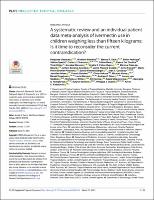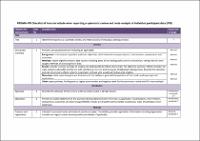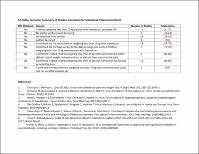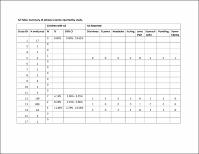| dc.contributor | Vall d'Hebron Barcelona Hospital Campus |
| dc.contributor.author | Jittamala, Podjanee |
| dc.contributor.author | Monteiro, Wuelton |
| dc.contributor.author | Smit, Menno R. |
| dc.contributor.author | Pedrique, Belen |
| dc.contributor.author | Specht, Sabine |
| dc.contributor.author | Chaccour, Carlos J. |
| dc.contributor.author | Soriano Arandes, Antoni |
| dc.date.accessioned | 2021-11-12T08:53:34Z |
| dc.date.available | 2021-11-12T08:53:34Z |
| dc.date.issued | 2021-03-17 |
| dc.identifier.citation | Jittamala P, Monteiro W, Smit MR, Pedrique B, Specht S, Chaccour CJ, et al. A systematic review and an individual patient data meta-analysis of ivermectin use in children weighing less than fifteen kilograms: is it time to reconsider the current contraindication? PLoS Negl Trop Dis. 2021 Mar 17;15(3):e0009144. |
| dc.identifier.issn | 1935-2735 |
| dc.identifier.uri | https://hdl.handle.net/11351/6536 |
| dc.description | Esdeveniments adversos; Nens; Oncocercosi |
| dc.description.sponsorship | KCK was supported in part by a Fellowship from the US National Research Council. WM is supported in part by a Fellowship from the National Council for Scientific and Technological Development (CNPq) and by Fapem (Pró-Estado). BP and SS are supported by the Drugs for Neglected Diseases initiative (DNDi). A full list of DNDi’s donors can be found at http://www.dndi.org/donors/donors/. The Infectious Disease Data Observatory and WorldWide Antimalarial Research Network are supported by the Bill & Melinda Gates Foundation and the Exxon Mobil Foundation. The funders had no role in study design, data collection and analysis, decision to publish, or preparation of the manuscript. |
| dc.language.iso | eng |
| dc.publisher | Public Library of Science |
| dc.relation.ispartofseries | PLoS Neglected Tropical Diseases;15(3) |
| dc.rights | Attribution 4.0 International |
| dc.rights.uri | http://creativecommons.org/licenses/by/4.0/ |
| dc.source | Scientia |
| dc.subject | Pediatria |
| dc.subject | Antibiòtics macròlids - Ús terapèutic |
| dc.subject | Antibiòtics macròlids - Efectes secundaris |
| dc.subject.mesh | Pediatrics |
| dc.subject.mesh | /administration & dosage |
| dc.subject.mesh | Contraindications, Drug |
| dc.title | A systematic review and an individual patient data meta-analysis of ivermectin use in children weighing less than fifteen kilograms: is it time to reconsider the current contraindication? |
| dc.type | info:eu-repo/semantics/article |
| dc.identifier.doi | 10.1371/journal.pntd.0009144 |
| dc.subject.decs | pediatría |
| dc.subject.decs | ivermectina |
| dc.subject.decs | /administración & dosificación |
| dc.subject.decs | contraindicaciones de los medicamentos |
| dc.relation.publishversion | https://doi.org/10.1371/journal.pntd.0009144 |
| dc.type.version | info:eu-repo/semantics/publishedVersion |
| dc.audience | Professionals |
| dc.contributor.organismes | Institut Català de la Salut |
| dc.contributor.authoraffiliation | [Jittamala P] Department of Tropical Hygiene, Faculty of Tropical Medicine, Mahidol University, Bangkok, Thailand. Mahidol-Oxford Tropical Medicine Research Unit, Faculty of Tropical Medicine, Mahidol University, Bangkok, Thailand. [Monteiro W] Fundação de Medicina Tropical Dr. Heitor Vieira Dourado, Manaus, Brazil. Universidade do Estado do Amazonas, Manaus, Brazil. [Smit MR] Amsterdam Centre for Global Child Health, Emma Children's Hospital, Amsterdam, The Netherlands. University Medical Centres, University of Amsterdam, Amsterdam, The Netherlands. Malaria Epidemiology Unit, Department of Clinical Sciences, Liverpool School of Tropical Medicine, Liverpool, United Kingdom. [Pedrique B, Specht S] Drugs for Neglected Diseases initiative (DNDi), Geneva, Switzerland. [Chaccour CJ] ISGlobal, Hospital Clínic-Universitat de Barcelona, Barcelona, Spain. Centro de Investigação em Saúde de Manhiça, Maputo, Mozambique. Ifakara Health Institute, Ifakara, United Republic of Tanzania. Instituto de Medicina Tropical Universidad de Navarra, Pamplona, Spain. [Soriano-Arandes A] Unitat de Patologia Infecciosa i Immunodeficiències de Pediatria, Vall d'Hebron Hospital Universitari, Barcelona, Spain. Vall d'Hebron Institut de Recerca (VHIR), Barcelona, Spain |
| dc.identifier.pmid | 33730099 |
| dc.identifier.wos | 000630374800002 |
| dc.rights.accessrights | info:eu-repo/semantics/openAccess |




